INTERNATIONAL
STANDARD
ISO
26262-6
First edition
2011-11-15
Road vehicles — Functional safety —
Part 6:
Product development at the software
level
Véhicules routiers — Sécurité fonctionnelle —
Partie 6: Développement du produit au niveau du logiciel
Reference number
ISO 26262-6:2011(E)
© ISO 2011
�
ISO 26262-6:2011(E)
COPYRIGHT PROTECTED DOCUMENT
© ISO 2011
All rights reserved. Unless otherwise specified, no part of this publication may be reproduced or utilized in any form or by any means,
electronic or mechanical, including photocopying and microfilm, without permission in writing from either ISO at the address below or
ISO's member body in the country of the requester.
ISO copyright office
Case postale 56 CH-1211 Geneva 20
Tel. + 41 22 749 01 11
Fax + 41 22 749 09 47
E-mail copyright@iso.org
Web www.iso.org
Published in Switzerland
ii
© ISO 2011 – All rights reserved
�
ISO 26262-6:2011(E)
Contents
Page
Foreword ............................................................................................................................................................. v
Introduction ........................................................................................................................................................ vi
1
2
3
4
4.1
4.2
4.3
5
5.1
5.2
5.3
5.4
5.5
6
6.1
6.2
6.3
6.4
6.5
7
7.1
7.2
7.3
7.4
7.5
8
8.1
8.2
8.3
8.4
8.5
9
9.1
9.2
9.3
9.4
9.5
Scope ...................................................................................................................................................... 1
Normative references ............................................................................................................................ 2
Terms, definitions and abbreviated terms .......................................................................................... 2
Requirements for compliance .............................................................................................................. 2
General requirements ........................................................................................................................... 2
Interpretations of tables ........................................................................................................................ 2
ASIL-dependent requirements and recommendations ..................................................................... 3
Initiation of product development at the software level .................................................................... 3
Objectives .............................................................................................................................................. 3
General ................................................................................................................................................... 3
Inputs to this clause .............................................................................................................................. 4
Requirements and recommendations ................................................................................................. 4
Work products ....................................................................................................................................... 6
Specification of software safety requirements................................................................................... 6
Objectives .............................................................................................................................................. 6
General ................................................................................................................................................... 7
Inputs to this clause .............................................................................................................................. 7
Requirements and recommendations ................................................................................................. 7
Work products ....................................................................................................................................... 9
Software architectural design .............................................................................................................. 9
Objectives .............................................................................................................................................. 9
General ................................................................................................................................................... 9
Inputs to this clause .............................................................................................................................. 9
Requirements and recommendations ............................................................................................... 10
Work products ..................................................................................................................................... 15
Software unit design and implementation ........................................................................................ 15
Objectives ............................................................................................................................................ 15
General ................................................................................................................................................. 15
Inputs to this clause ............................................................................................................................ 16
Requirements and recommendations ............................................................................................... 16
Work products ..................................................................................................................................... 18
Software unit testing ........................................................................................................................... 19
Objectives ............................................................................................................................................ 19
General ................................................................................................................................................. 19
Inputs to this clause ............................................................................................................................ 19
Requirements and recommendations ............................................................................................... 19
Work products ..................................................................................................................................... 21
Software integration and testing ....................................................................................................... 22
10
Objectives ............................................................................................................................................ 22
10.1
General ................................................................................................................................................. 22
10.2
Inputs to this clause ............................................................................................................................ 22
10.3
10.4
Requirements and recommendations ............................................................................................... 23
10.5 Work products ..................................................................................................................................... 25
11
Verification of software safety requirements ................................................................................... 25
© ISO 2011 – All rights reserved
iii
�
ISO 26262-6:2011(E)
Objectives .............................................................................................................................................25
11.1
General ..................................................................................................................................................25
11.2
Inputs to this clause ............................................................................................................................25
11.3
11.4
Requirements and recommendations ...............................................................................................26
11.5 Work products ......................................................................................................................................27
Annex A (informative) Overview of and workflow of management of product development at the
software level .......................................................................................................................................28
Annex B (informative) Model-based development .........................................................................................31
Annex C (normative) Software configuration .................................................................................................33
Annex D (informative) Freedom from interference between software elements ........................................38
Bibliography ......................................................................................................................................................40
iv
© ISO 2011 – All rights reserved
�
ISO 26262-6:2011(E)
Foreword
ISO (the International Organization for Standardization) is a worldwide federation of national standards bodies
(ISO member bodies). The work of preparing International Standards is normally carried out through ISO
technical committees. Each member body interested in a subject for which a technical committee has been
established has the right to be represented on that committee. International organizations, governmental and
non-governmental, in liaison with ISO, also take part in the work. ISO collaborates closely with the
International Electrotechnical Commission (IEC) on all matters of electrotechnical standardization.
International Standards are drafted in accordance with the rules given in the ISO/IEC Directives, Part 2.
The main task of technical committees is to prepare International Standards. Draft International Standards
adopted by the technical committees are circulated to the member bodies for voting. Publication as an
International Standard requires approval by at least 75 % of the member bodies casting a vote.
Attention is drawn to the possibility that some of the elements of this document may be the subject of patent
rights. ISO shall not be held responsible for identifying any or all such patent rights.
ISO 26262-6 was prepared by Technical Committee ISO/TC 22, Road vehicles, Subcommittee SC 3,
Electrical and electronic equipment.
ISO 26262 consists of the following parts, under the general title Road vehicles — Functional safety:
Part 1: Vocabulary
Part 2: Management of functional safety
Part 3: Concept phase
Part 4: Product development at the system level
Part 5: Product development at the hardware level
Part 6: Product development at the software level
Part 7: Production and operation
Part 8: Supporting processes
Part 9: Automotive Safety Integrity Level (ASIL)-oriented and safety-oriented analyses
Part 10: Guideline on ISO 26262
© ISO 2011 – All rights reserved
v
�
ISO 26262-6:2011(E)
Introduction
ISO 26262 is the adaptation of IEC 61508 to comply with needs specific to the application sector of electrical
and/or electronic (E/E) systems within road vehicles.
This adaptation applies to all activities during the safety lifecycle of safety-related systems comprised of
electrical, electronic and software components.
Safety is one of the key issues of future automobile development. New functionalities not only in areas such
as driver assistance, propulsion, in vehicle dynamics control and active and passive safety systems
increasingly touch the domain of system safety engineering. Development and integration of these
functionalities will strengthen the need for safe system development processes and the need to provide
evidence that all reasonable system safety objectives are satisfied.
With the trend of increasing technological complexity, software content and mechatronic implementation, there
are increasing risks from systematic failures and random hardware failures. ISO 26262 includes guidance to
avoid these risks by providing appropriate requirements and processes.
System safety is achieved through a number of safety measures, which are implemented in a variety of
technologies (e.g. mechanical, hydraulic, pneumatic, electrical, electronic, programmable electronic) and
applied at the various levels of the development process. Although ISO 26262 is concerned with functional
safety of E/E systems, it provides a framework within which safety-related systems based on other
technologies can be considered. ISO 26262:
a) provides an automotive safety lifecycle (management, development, production, operation, service,
decommissioning) and supports tailoring the necessary activities during these lifecycle phases;
b) provides an automotive-specific risk-based approach to determine integrity levels [Automotive Safety
Integrity Levels (ASIL)];
c) uses ASILs to specify applicable requirements of ISO 26262 so as to avoid unreasonable residual risk;
d) provides requirements for validation and confirmation measures to ensure a sufficient and acceptable
level of safety being achieved;
e) provides requirements for relations with suppliers.
Functional safety is influenced by the development process (including such activities as requirements
specification, design, implementation, integration, verification, validation and configuration), the production
and service processes and by the management processes.
Safety issues are intertwined with common function-oriented and quality-oriented development activities and
work products. ISO 26262 addresses the safety-related aspects of development activities and work products.
Figure 1 shows the overall structure of this edition of ISO 26262. ISO 26262 is based upon a V-model as a
reference process model for the different phases of product development. Within the figure:
the shaded “V”s represent the interconnection between ISO 26262-3, ISO 26262-4, ISO 26262-5,
ISO 26262-6 and ISO 26262-7;
the specific clauses are indicated in the following manner: “m-n”, where “m” represents the number of the
particular part and “n” indicates the number of the clause within that part.
EXAMPLE
“2-6” represents Clause 6 of ISO 26262-2.
vi
© ISO 2011 – All rights reserved
�
ISO 26262-6:2011(E)
Figure 1 — Overview of ISO 26262
© ISO 2011 – All rights reserved
vii
�
�
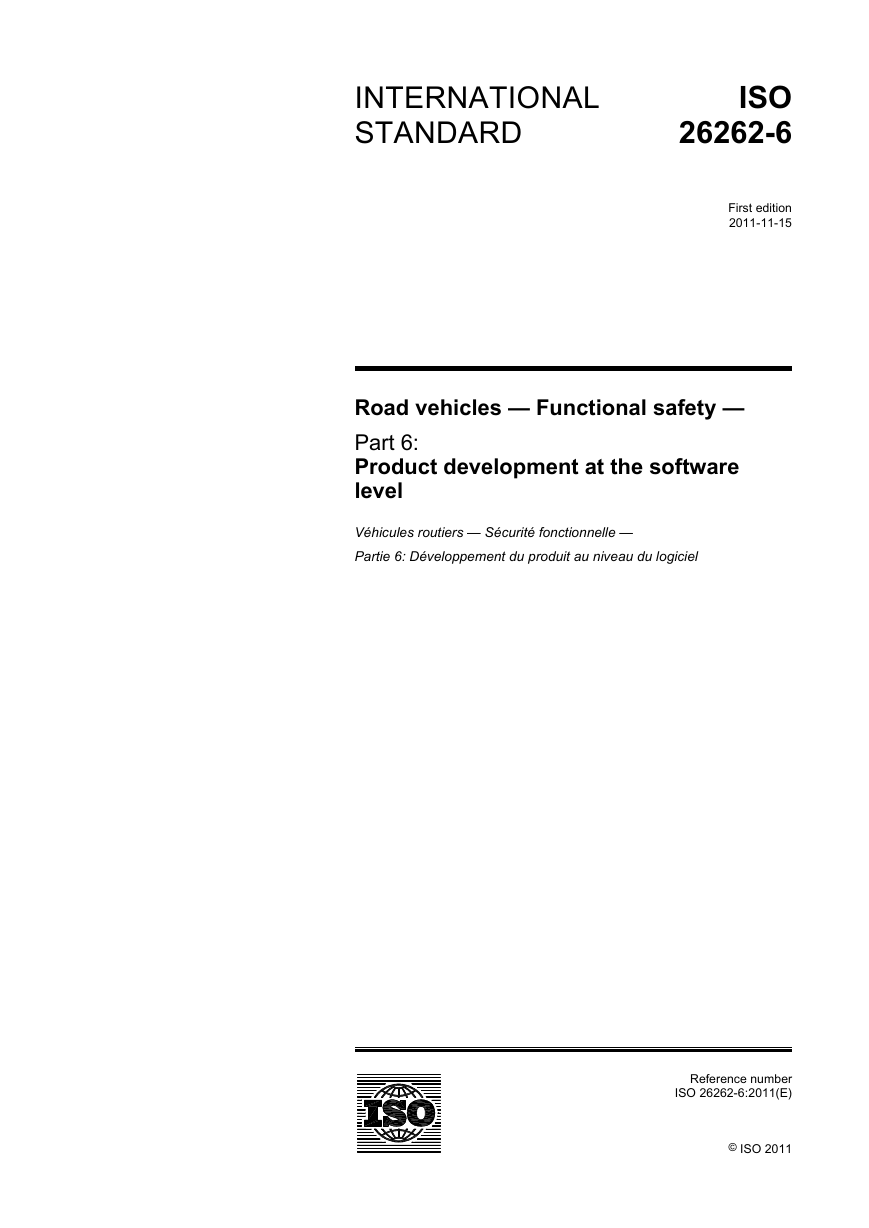
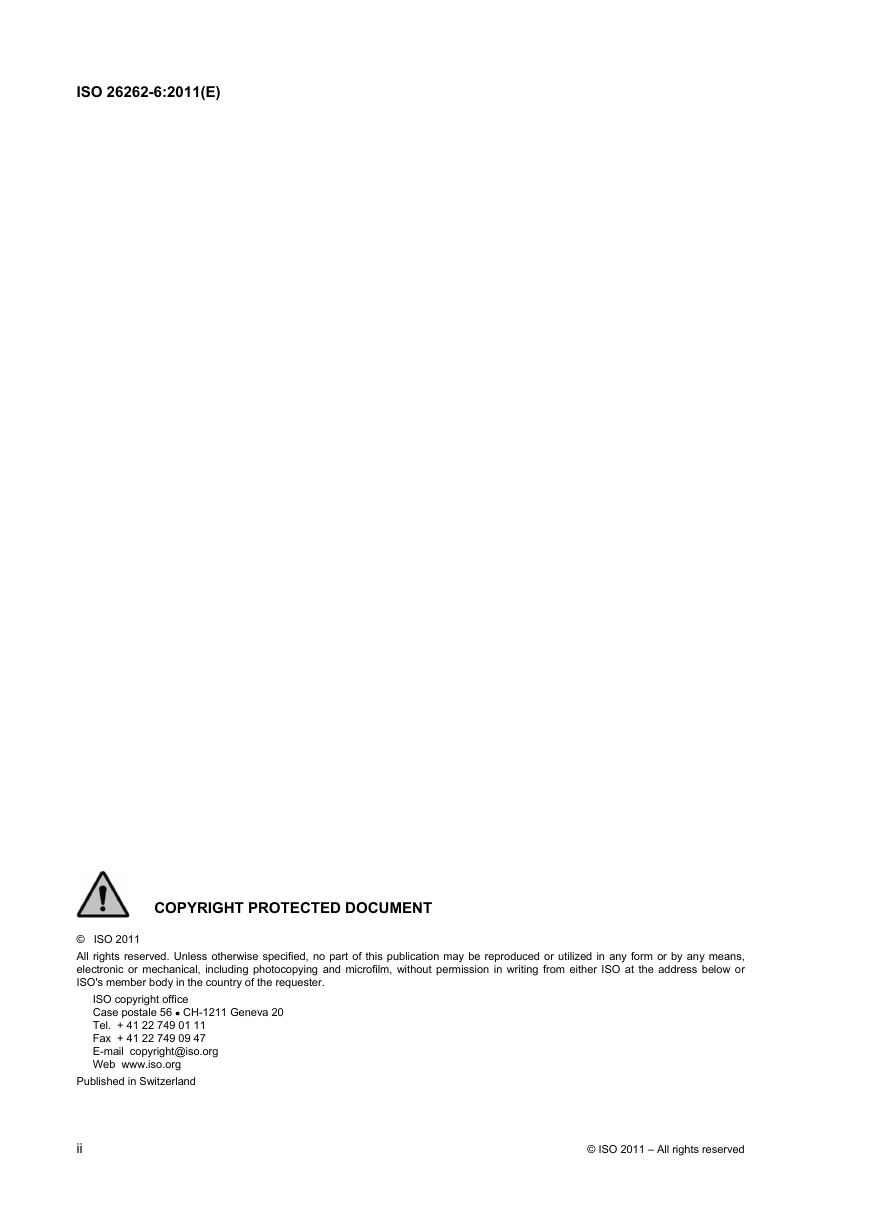
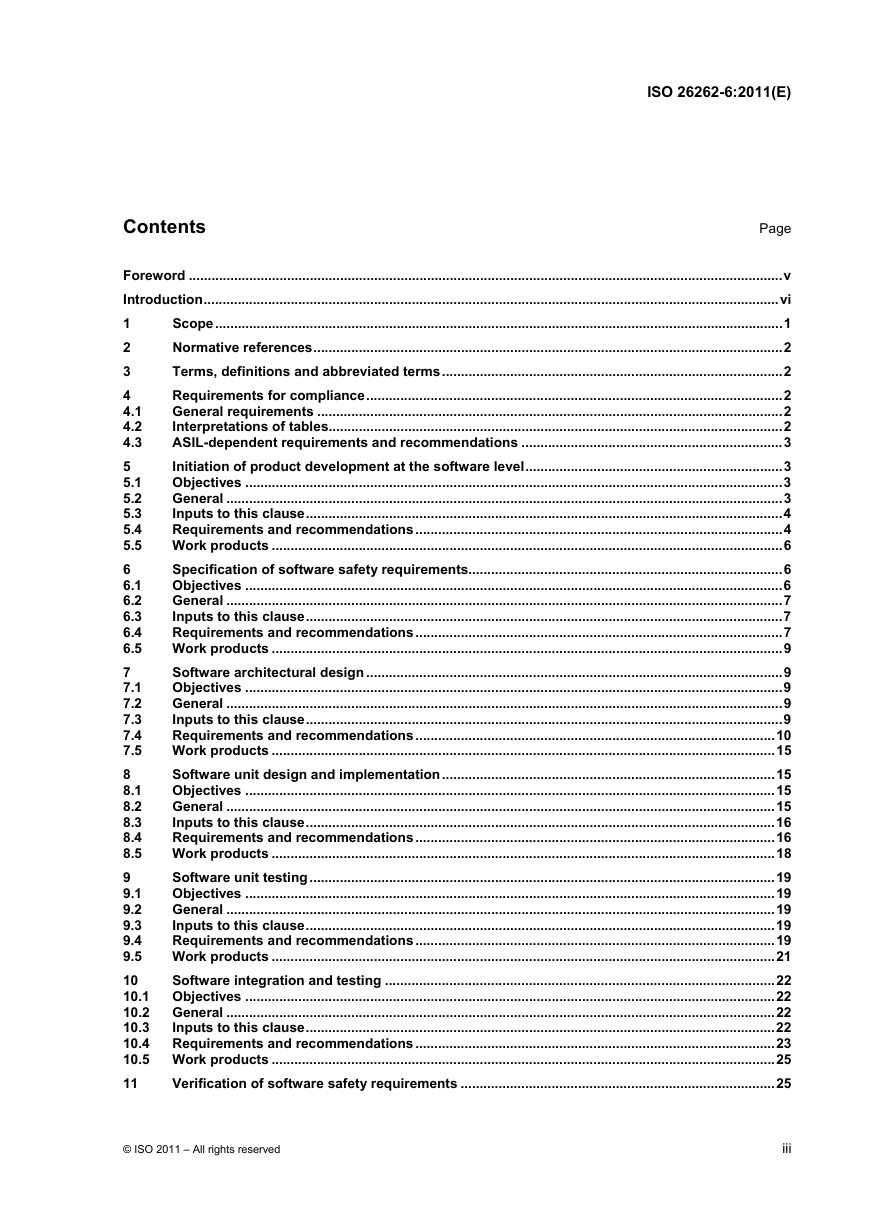
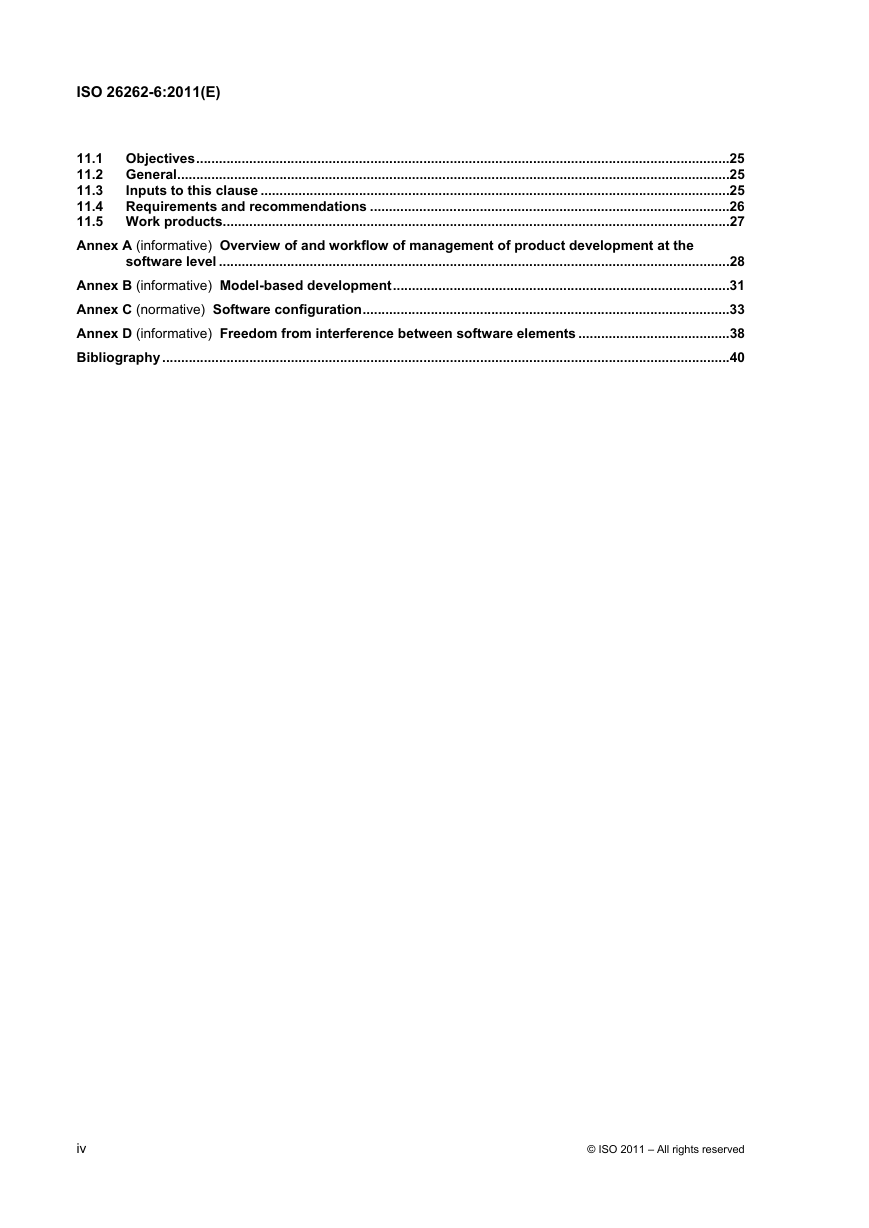
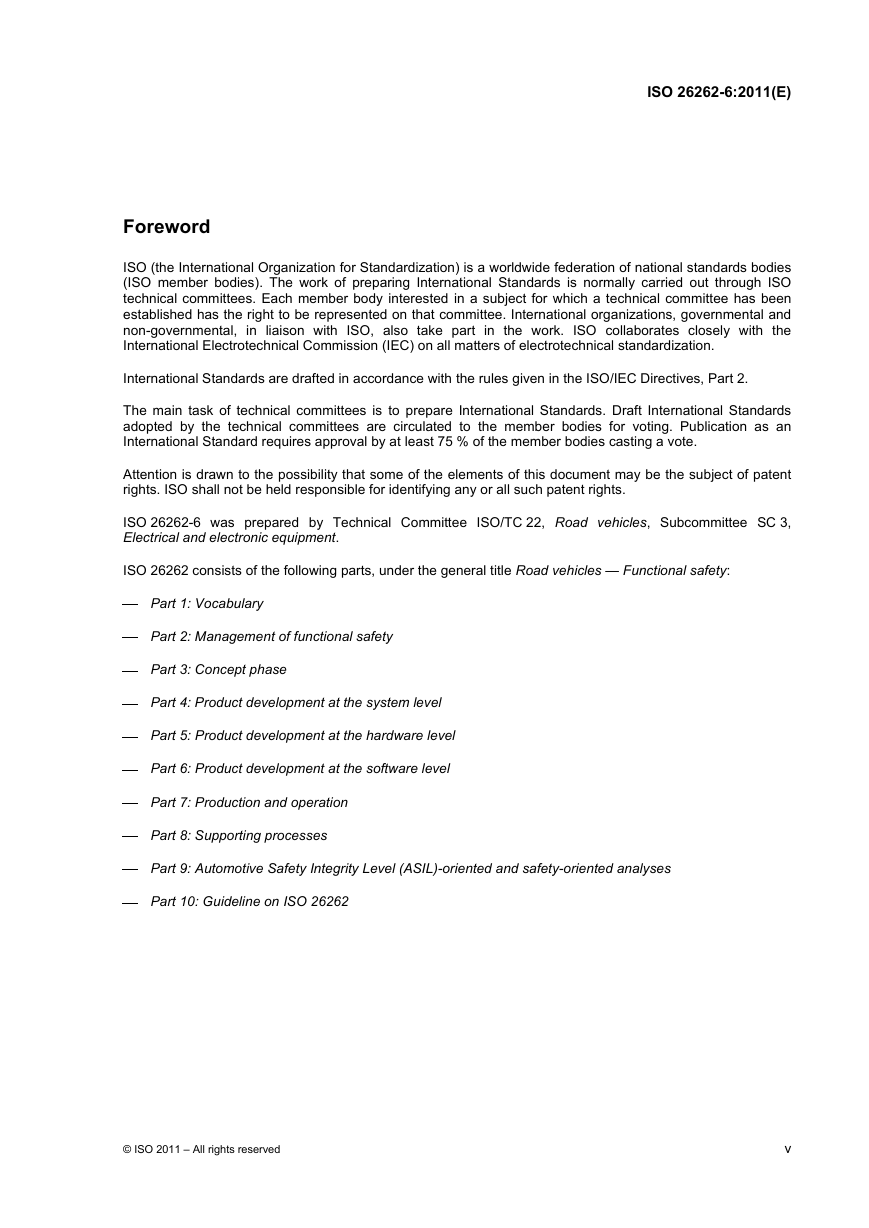
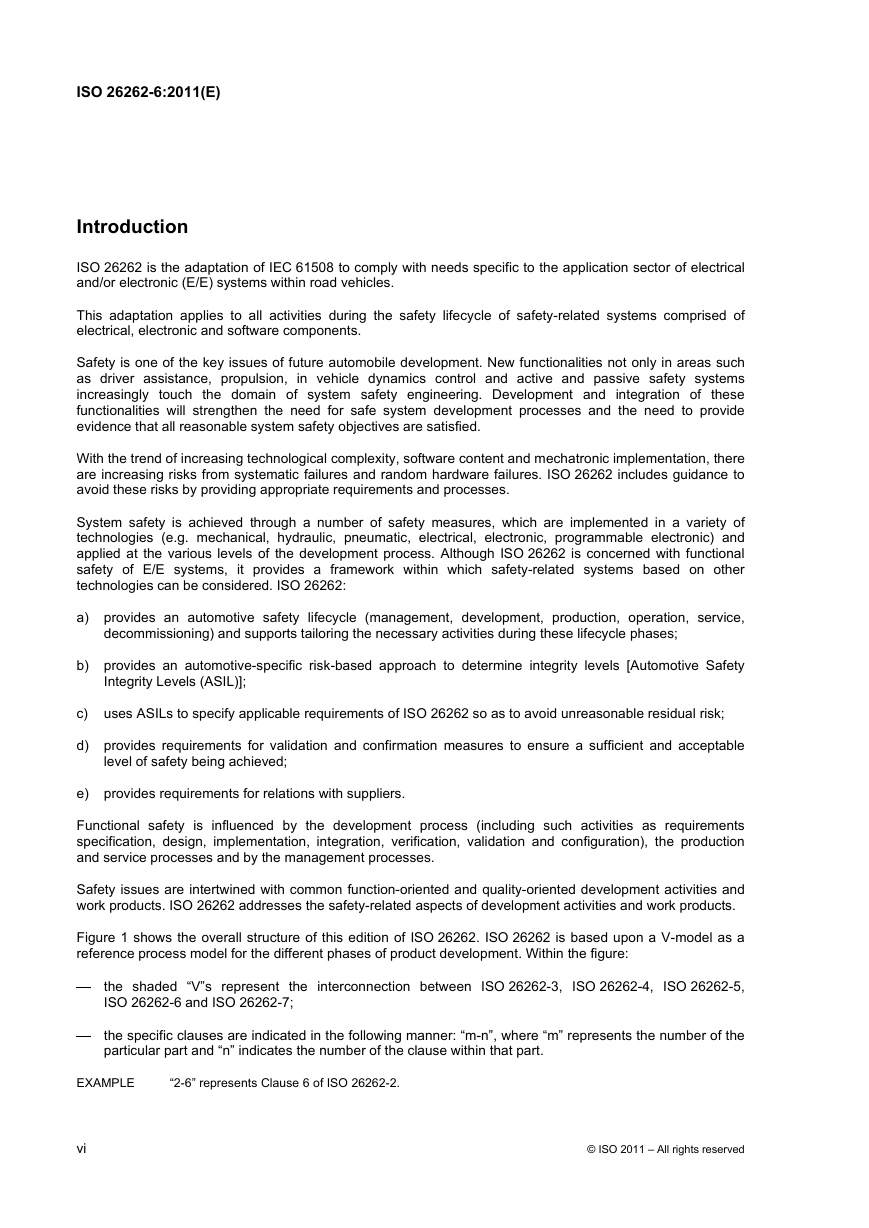
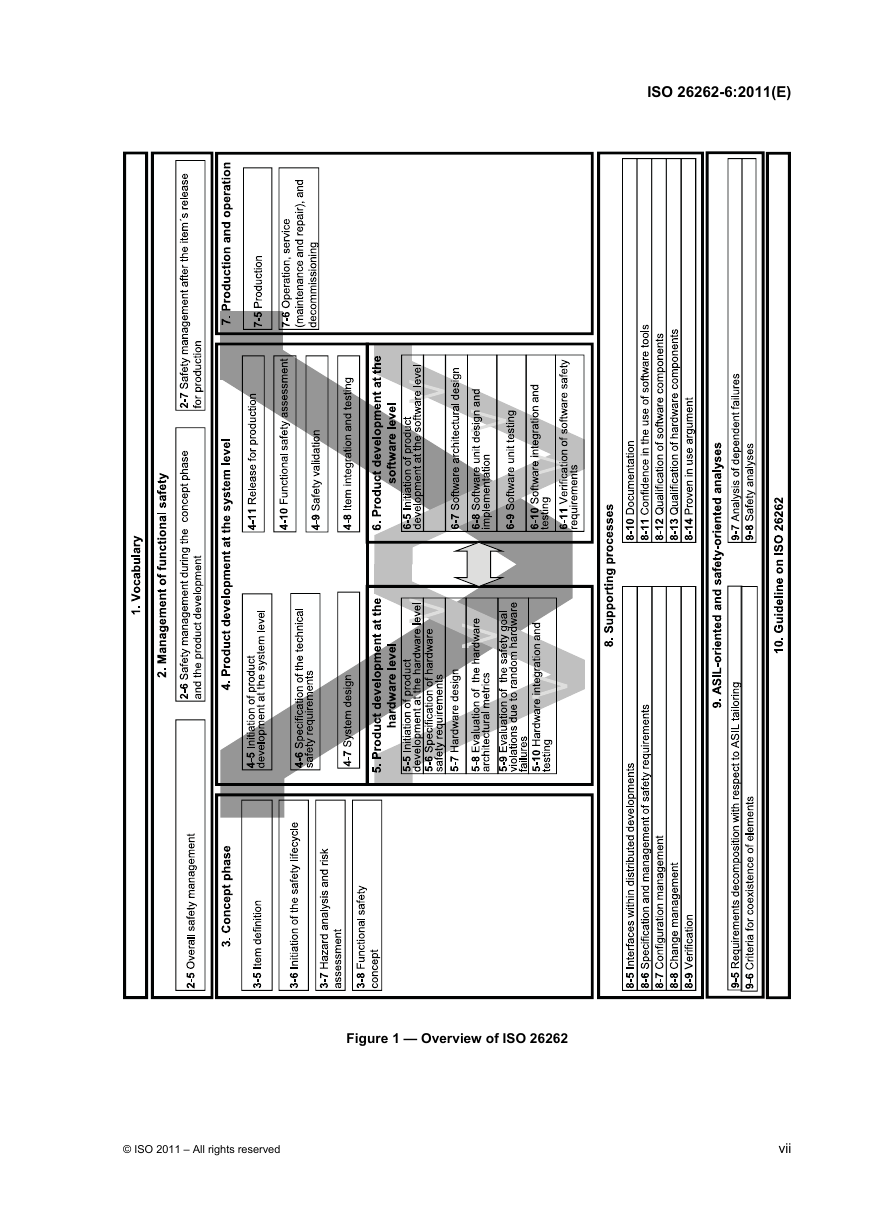









 2023年江西萍乡中考道德与法治真题及答案.doc
2023年江西萍乡中考道德与法治真题及答案.doc 2012年重庆南川中考生物真题及答案.doc
2012年重庆南川中考生物真题及答案.doc 2013年江西师范大学地理学综合及文艺理论基础考研真题.doc
2013年江西师范大学地理学综合及文艺理论基础考研真题.doc 2020年四川甘孜小升初语文真题及答案I卷.doc
2020年四川甘孜小升初语文真题及答案I卷.doc 2020年注册岩土工程师专业基础考试真题及答案.doc
2020年注册岩土工程师专业基础考试真题及答案.doc 2023-2024学年福建省厦门市九年级上学期数学月考试题及答案.doc
2023-2024学年福建省厦门市九年级上学期数学月考试题及答案.doc 2021-2022学年辽宁省沈阳市大东区九年级上学期语文期末试题及答案.doc
2021-2022学年辽宁省沈阳市大东区九年级上学期语文期末试题及答案.doc 2022-2023学年北京东城区初三第一学期物理期末试卷及答案.doc
2022-2023学年北京东城区初三第一学期物理期末试卷及答案.doc 2018上半年江西教师资格初中地理学科知识与教学能力真题及答案.doc
2018上半年江西教师资格初中地理学科知识与教学能力真题及答案.doc 2012年河北国家公务员申论考试真题及答案-省级.doc
2012年河北国家公务员申论考试真题及答案-省级.doc 2020-2021学年江苏省扬州市江都区邵樊片九年级上学期数学第一次质量检测试题及答案.doc
2020-2021学年江苏省扬州市江都区邵樊片九年级上学期数学第一次质量检测试题及答案.doc 2022下半年黑龙江教师资格证中学综合素质真题及答案.doc
2022下半年黑龙江教师资格证中学综合素质真题及答案.doc